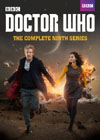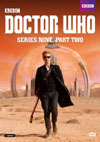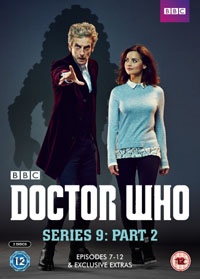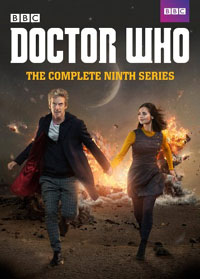DVD Extras for this story on the 14-episode box sets include:
However, one of the biggest reasons why this story is such a strong contender to be my favourite of Doctor Who's 35th season is that it takes its own sweet time to explore in-depth (and with powerful elements of reality and poignant metaphor) the ultimately more fascinating challenge of not just ending a vicious tooth-and-nail alien invasion story with an arbitrary peace, but more to the point figuring out what comes next. How many times have I ended previous reviews by saying such an interesting situation, like taking an antagonist who turns good and trying to re-integrate them into society, is just about poised to start just as the episode bows out or cops out, often violently? ..."Black Orchid" (story no. 121), "The Silurians" (story no. 52), "The Sea Devils" (story no. 62), "The Hungry Earth" (story no. 214), "Arc of Infinity" (story no. 124), "The Two Doctors" (story no. 141), even "Terminus" (story no. 127) to some extent.
The central theme seen here of pausing violence is much the same theme that we saw back in Peter Harness's Moon story from the previous year, but the mechanisms through which the theme manifests into plot and characterizations work so much better in this story, the difference is like night and day. Instead of completely offending science and common sense and characterization with a misuse of basic ideas, we can instead here invest in some proper sci-fi staples like identity theft through duplicates via an established threatening alien race. Harness proves much more adept at utilizing the possibilities with this situation.
Reality-scapeThe two episodes have noticeably different tones and strengths. The first episode is credited to Peter Harness alone, and it manages to hold up a mirror to many elements of our own society better than the second episode will manage. It also has fantastic scope and cinematic values. It has a unique power to it, and it says quite a few worthwhile things. On the downside though, it doesn't quite sustain a keen sense of drive all the way through, and I would cite two sequences in particular that commit some fundamental mistakes.The opening hook is really nice, as it economically recaps everything we really need to know from "The Day of the Doctor" (which is surprisingly little), and charges full blast into a very thematic way of demonstrating not just how Osgood can continue on the show after her last appearance, but why the flavour of that continuance might send ripples throughout the world's political stability. Excellent. But more excellence seems to be a bit too scarce as the story ambles along afterward, as Harness struggles to find truly interesting ways of bringing the rest of the cast of characters into the mix. One of the two big fundamental mistakes is the very questionable imagery of an old Doctor urgently trying to chat up two very young girls in a schoolyard. Much better would have been a proper TARDIS materialization followed by a more useful disguise for leaders of the Zygon council. When at last the Doctor, Clara, Kate Stewart, and Jac all come together, we get a good scene that focuses the plot, and splits them off onto three different story threads in different countries, each of which contains very good and very atmospheric material. That said, there were often times when I remained a bit unclear on why there were three threads and not just two, or which thread Osgood was meant to be in. But the material is generally quite good, and evokes many of the difficult situations handled by actual peacekeepers today, while bringing many of their actions under the microscope and successfully asking whether or not such actions actually help the peace or escalate the conflict. The metaphors are rich and mostly good. Kate Stewart's comments in that scene with the Doctor are also poignant, noting that there was a treaty between Humans and Zygons, and the Zygons have now totally disregarded their part. But as always the Doctor dissuades her from moving towards an escalation of violence, and back towards a re-negotiation of the peace. It's a good dynamic there. Kate Stewart's entire New Mexico sequence is effective - with all the moody atmospheric establishing material, and then the rich dialogue with the police officer that explores racial/geographic prejudice, first U.S. against Brit, then U.S. against Zygon, then Zygon against Human. You could insert any indigenous race against immigrant, and immigrant against native, with cultural intolerance on top. Plus, the audience has time to think about the issues and hear their own thoughts while the show is still running, thanks to all the lengthy atmospheric scenes with little dialogue that often accompany the shift from one thread to another - one of the bonuses that comes from a two-parter having the space to breathe. And quite often, the metaphors are simply in the imagery instead of the dialogue. A lot of the most effective of those purely cinematic moments come from the thread of Clara and Jac exploring Zygon activities in the underground areas - some of the most atmospheric sequences of the entire season. The Human commander in Turmezistan is also an important character in that she paints a picture of the rationality of one of the worst extremes. Her character is one of those people who justify the use of violence to solve world situations, yet she has a level of practicality in everything she says. Her analyses of the situation are often proven correct, even if her recommended courses of action are subsequently so far from ideal. Her scene chatting with the Doctor outside the U.N.I.T. base of operations in Turmezistan, highlighting the reality of her paranoia, is probably her best. The Doctor's confrontation with the captured Zygon on board his airplane is also key. The Zygon's culture has been too cramped, squeezed into Human rules, forced to make do with Human governments deciding the future of his people, forced to live a lie. Some of the things he says he wants are legitimate things to request - many of the same things that I'd recommend for diffusing the tensions. Sadly it is perhaps one of the most memorable of these scenes that goes off-colour and becomes the second of the episode's fundamental errors - the stand-off of the S.W.A.T. team at the church. There seems to be so much wrong with this sequence. Members of S.W.A.T. teams have so much training drilled into them, which takes over when they enter a scenario, they should never appear as clueless as these troops do, particularly if they'd had extra U.N.I.T. training for all the possibilities that Zygons can throw at them. "Mom" coming out of the church also clearly demonstrates dangerous body language by continuously advancing on the troops - and the Zygons shouldn't be that stupid if they plan to draw the troopers into the building. Coming back to the main theme, why does all the tension rest between only two choices - either shoot to kill or do nothing? Can you not give "Mom" an order to stand still, hands above her head, or use some weapon that incapacitates if she doesn't comply? Guns are a bit silly here. The biggest kicker of all is that the Doctor is here, endorsing this mission, and not really saying or doing anything to help it play out according to the better ideal that he must already have in his head. Considering what a HUGE speech he makes at the end of the adventure, and considering what that speech is, it becomes very inconsistent to see him present at this standoff with absolutely nothing to say on the subject. In the end, it is because a few sequences like this went so far bad that this story won't be able to rise out of the "decent" category to stand amongst Doctor Who's most excellent adventures. I did find it noticeably strange that nearly all of the speaking parts in this episode go to women, even with so many of those characters belonging to police and military organizations. I felt that that went a bit TOO far to reflect reality well. As Chandler asked in "The One With Ross's Teeth" (Friends, season six), where are all the men? Many a classic-era commentary has discussed the infamous question marks that ex-producer John Nathan-Turner pushed upon the costumes of the fourth, fifth, sixth, and seventh Doctors, but this is I think the first time they have actually been discussed in the on-screen dialogue of a canon Doctor Who episode. I've always accepted the "question marks" wholeheartedly, but under an assumption that no one else ever seems to get or propose - that this is really some ancient Gallifreyan/alien symbol which means something completely different and relevant to the Doctor's heritage. And probably due to his mysterious ways, as he influenced early Human culture on one of his adventures way back in Earth's past, we adopted this symbol as the embodiment of a question. This makes it far less silly. It is in fact probably incorrect to call them question marks - the Doctor should have his own word for the symbol. It should be like the "S" on Superman's costume not really being "S" as in "super", but rather it is the symbolic family crest of the "El" family on the planet Krypton. At any rate, much of the best material in this story is simply Peter Capaldi's Doctor sharing dialogue with Ingrid Oliver's Osgood which is rich in its exploration of both characters, their emotional quirks, the strength with which they keep their secrets, and the various nuts and bolts required to maintain a Human/Zygon peace. The Doctor's story thread improves enormously once it settles into this groove. Each and every thread manages to escalate well and draw together into a triple threat cliffhanger which works remarkably powerfully for being so leisurely paced.
Inverted StrengthsThe second episode achieves a much different tone and uses a different set of strengths, which I believe is reflected in it being credited to both Peter Harness and Steven Moffat. This episode has a much stronger sense of drive to it, with the characters being a bit better focused on what they're doing in ways that help the audience to keep right up and stay with them and root for them. There aren't really any major fundamental mistakes in the narrative. It's also interesting in that the action is now totally contained within England, with events all revolving around one particular Zygon villain. The downside is that it's no longer as powerful as it used to be in reflecting real situations and commenting on them. This episode feels a bit more like fantasy entertainment - thankfully of a high quality.The character of Etoine - the hapless Zygon who just wants to live and work and go about his day - is key to the nice reversal that takes place in this episode, and really helps the audience to get on side with the Doctor's ultimate stance on the issues. And apparently, Clara didn't quite have as much to do in the first episode as we might have thought at first, so it is nice to see her having a strong influence in this episode once again. Jenna Coleman gets lots to do in this episode, and is strong enough to carry many scenes excellently all on her own. The Doctor's quality time with Osgood continues here, and they get about twice as much material as before, which continues to work very well and keep the story rolling.
The other caveat is that it really isn't much different from the previous end of this dangling plot that we already saw back in "The Day of the Doctor", and it even has dialogue to reference that fact. Which begs the question, did we really make any progress in this adventure? But perhaps there is an implied answer to that. Perhaps peace is simply going to require continued work, continued vigilance, and a willingness to be ever ready to negotiate, talk aggressors down, ask people what they REALLY want, and get them on a better path to achieving it. But perhaps something else that is fundamental was really missed here. Conflict doesn't sprout in a vacuum simply because peace has been forgotten or undervalued. Conflict usually has central issues behind it which need to be addressed, issues which don't simply melt away by deciding to pluck a guitar and sing "Kumbaya" in harmony. Perhaps Zygons need more of their own space, perhaps they deserve to live as themselves instead of pretending to be white European Humans, perhaps they deserve to embody and display their own culture proudly. The "Truth" part of this story's palette seems to be a bit too silent at this conclusion, and this is what could perhaps carry the issues and characters forward, so that they no longer need to keep repeating the same mistake over and over. Has Kate Stewart really done this 15 times since "Day of the Doctor"? (Perhaps this is the first time it got so out of hand via the Osgood situation though.)
International Titles:Deutsch: "Die Inversion der Zygonen"
Magyar: "A Zygonok"
Français: "Vérité ou Conséquences"
Русский: "Преображение зайгонов"
Italiano: "L'inversione degli Zygon"
Bizarrely, the French decided to knit both episodes together under the single title "Truth or Consequences". Huh? I don't really get it. This time around, the French will have my least favourite set of titles for the story.
This story is available on DVD and Blu-ray:
Comments on this article are welcome. You may contact the author from this page:
|
||||||||||||||||||||||||||||












